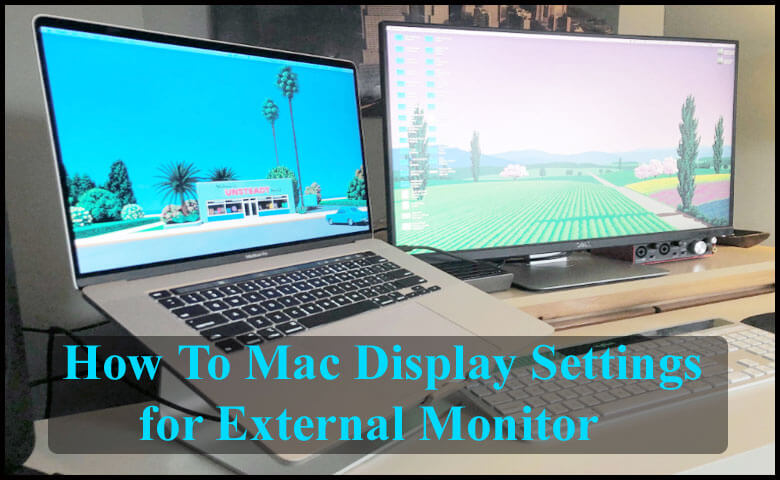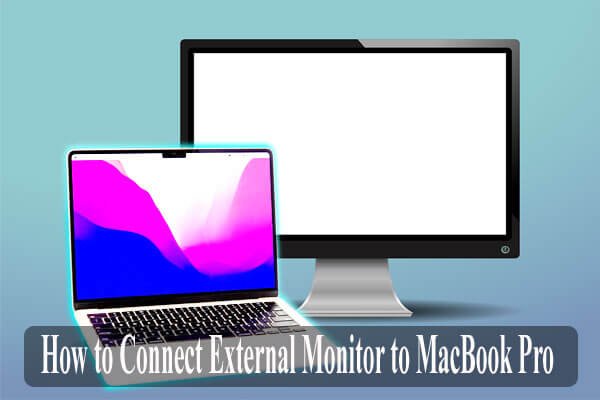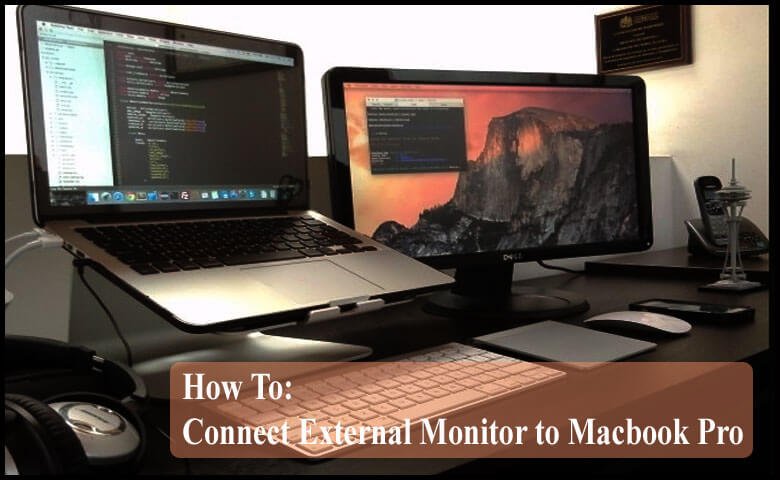Yes, a Mac Pro can connect to any monitor. However, there are some considerations that you should take into account before making this decision.
First and foremost, make sure that the monitor is compatible with your Mac Pro. Secondly, be sure to determine the optimal resolution for your needs. Finally, make sure that the ports on your Mac Pro are configured correctly in order to allow for proper connection.
If you’re using a Macbook Pro with an external monitor, you may have noticed that the display is Mirroring instead of connecting directly. This is because Apple doesn’t allow screens to be connected directly without additional software.
In this post, I will teach you how to connect your external monitor to Macbook Pro using a workaround. It’s easy to connect an external monitor to your Macbook Pro. All you need is a Mini DisplayPort-to-VGA adapter and a VGA cable.
List of Contents
- How to Connect a Macbook Pro to a Monitor – Comprehension Guide
- MacBook Pro Not Detecting External Display
- How to Connect External Monitor to Macbook Air
- MacBook Pro Dual Monitor Setup
- Best External Monitor for Macbook Pro
- How to Connect Mac to Monitor HDMI
- Switch to External Monitor Mac Shortcut
- External Monitor for Macbook Pro
- Mac Display Settings for External Monitor
- Why Can’t I Connect My Macbook Pro to an External Monitor?
- How Do I Connect My Macbook to a Monitor Using HDMI?
- How Do I Display My Macbook Screen on a Monitor?
- Conclusion
- Frequently Asked Question
- Can a Mac Pro Connect to Any Monitor?
How to Connect a Macbook Pro to a Monitor – Comprehension Guide
- Locate the video output port on your MacBook Pro
- This is typically located on the left side of the computer, near the MagSafe power adapter port
- Connect one end of an external video cable to the video output port on your MacBook Pro
- Connect the other end of the external video cable to the video input port on your external monitor
- Turn on your external monitor
- You may need to press a button or select a menu option to do this; consult your monitor’s documentation for more information
- Press “F11” on your MacBook Pro keyboard to enter full-screen mode and display your computer’s contents on the external monitor.
[irp posts=”4078″ ]
MacBook Pro Not Detecting External Display
If your MacBook Pro isn’t detecting your external display, there are a few potential things going on. First, make sure that both your MacBook Pro and the display are powered on. And then, that the appropriate cables are securely connected to both devices. If everything is plugged in and powered on but you’re still not seeing anything on your external display, try resetting the NVRAM or PRAM on your MacBook Pro.
To do this, shut down your computer and then turn it back on while holding down the Option + Command + P + R keys until you hear the startup chime twice. Once you’ve done that, try connecting to your external display again. If resetting the NVRAM doesn’t work. It’s possible that there’s an issue with either the connection between your MacBook Pro and the display.
Try disconnecting everything and then reconnecting it all making sure that all of the connections are secure. If you’re still having trouble after doing that, try testing with another display.
There may be an issue with your graphics card or GPU which is preventing your external display from being detected by your MacBook Pro. In this case, you’ll likely need to take it to an Apple Store or authorized service provider. You will do it for diagnosis and repair as this is not something that can be easily fixed at home.
How to Connect External Monitor to Macbook Air
If you have a MacBook Air and an external monitor, you can connect the two together to create an extended desktop. This is a great way to increase your productivity, as you’ll have more screen real estate to work with. Here’s how to do it:
- Connect one end of a Thunderbolt cable to your MacBook Air’s Thunderbolt port.
- Connect the other end of the cable to your external monitor’s HDMI port.
- Use the built-in Menu bar on your MacBook Air to adjust your display settings. Click on “System Preferences,” then “Displays.”
- In the “Arrangement” tab, you’ll see a representation of your monitors. Drag and drop the white menu bar from your MacBook Air onto your external monitor; this will indicate that you want your primary display to be on the external monitor.
- Make sure that the “Mirror Displays” checkbox is not checked. If it is, click on it to uncheck it. Now close System Preferences.
- Your external monitor should now be displaying your computer’s desktop! You can adjust its resolution by going back into System Preferences and clicking on “Displays” once again. Then, click on the “Scaled” radio button next to “Resolution.”
[irp posts=”3180″ ]
MacBook Pro Dual Monitor Setup
If you’ve ever wanted to connect your Macbook Pro to a dual monitor setup, it’s actually quite easy to do. All you need is a Mini DisplayPort-to-DVI Adapter (or Mini DisplayPort-to-VGA Adapter) and an extra monitor. Here’s a step-by-step guide on how to set it up:
- Connect the Mini DisplayPort end of the adapter to the Thunderbolt port on your Macbook Pro.
- Connect the DVI (or VGA) end of the adapter to the input port on your extra monitor.
- Adjust the resolution and refresh rate of your extra monitor according to its capabilities.
- You can do this by going into System Preferences > Displays.
- If everything looks good, you’re all set! You should now have a functional dual monitor setup with your Macbook Pro as the main display and your extra monitor as the secondary display.
Best External Monitor for Macbook Pro
When it comes to finding the best external monitor for your Macbook Pro, there are a few things you need to take into consideration. Firstly, what is the purpose of the monitor? Do you need it for work or play?
Secondly, what is your budget? And finally, what are the specific features that you are looking for in a monitor? If you need an external monitor for work purposes, then we would recommend something like the Dell UltraSharp U2715H 27-Inch Screen LED Monitor.
This monitor offers excellent color accuracy and clarity, making it perfect for productivity. It also has a wide range of ports, so you can easily connect all your peripherals. Plus, at $599.99, it won’t break the bank.
If you’re looking for an external monitor for gaming purposes, then we would recommend something like the Asus ROG Swift PG279Q 27″ IPS Gaming Monitor. This monitor offers an incredibly fast 165Hz refresh rate and NVIDIA G-Sync technology for smooth gameplay. Plus, at $799.99, it’s still reasonably priced compared to other gaming monitors on the market.
Finally, if you just need a basic external monitor for general use (like browsing the web or watching movies), then we would recommend something like the Acer SB220Q bi 21.5″ Full HD (1920 x 1080) IPS Ultra-Thin Zero Frame Widescreen LED Backlit Display.
This monitor is super affordable at just $109.99 and still offers decent picture quality and features such as AMD FreeSync technology to reduce screen tearing. So there you have it! These are our top picks for the best external monitors for Macbook Pros in 2022.
How to Connect Mac to Monitor HDMI
It is pretty easy to connect a Mac to an HDMI monitor. Just follow these simple steps and you will be up and running in no time:
- First, locate the HDMI port on your Mac. It is usually located on the back of the computer next to the Thunderbolt port.
- Next, take an HDMI cable and plug one end into the HDMI port on your Mac.
- Then, plug the other end of the cable into the HDMI input on your monitor.
- Finally, power on both your Mac and monitor. Your Mac should automatically detect the connected display and adjust its resolution accordingly. That’s it!
- You are now ready to enjoy all your favorite content on a larger screen!
[irp posts=”1670″ ]
Switch to External Monitor Mac Shortcut
If you’ve ever needed to quickly connect your Mac to an external monitor, there’s a handy shortcut you can use. With just a few keystrokes, you can have your Mac display on an external monitor in no time. Here’s how it works: First, make sure that your external monitor is powered on and connected to your Mac.
Then, press the Command+F2 keys on your keyboard. Your Mac will instantly switch to using the external monitor as its primary display. If you want to go back to using your Mac’s built-in display, simply press the Command+F2 keys again and your Mac will revert back to its original settings.
This shortcut is incredibly useful if you need to give a presentation or work on a project that requires a larger screen. It’s also great for when you want to watch a movie or TV show on a bigger screen than what your MacBook Pro or MacBook Air offers. So next time you need to quickly connect to an external monitor, remember the Command+F2 shortcut and save yourself some time!
External Monitor for Macbook Pro
If you’re a Mac user, you might be looking for an external monitor to supplement your laptop’s screen. There are a few things to consider when choosing an external monitor for your Macbook Pro. First, you’ll need to decide what size and resolution you want.
Larger monitors will obviously take up more desk space, but they also offer more real estate for working with multiple windows side-by-side. Higher resolutions will make text and images look sharper, but they can also make everything appear smaller on the screen. Once you’ve decided on the size and resolution of your external monitor, the next thing to consider is connectivity.
Most new monitors use HDMI or DisplayPort connections, which should work fine with your Macbook Pro. However, older monitors may use DVI or VGA connections. If your monitor uses one of these older connection types, you’ll need to buy an adapter in order to connect it to your laptop.
Finally, you’ll need to decide whether or not you want a touchscreen display. While touchscreen displays can be handy for some applications, they’re not necessary for most people. They also tend to add quite a bit of cost to the overall price tag of the monitor.
Mac Display Settings for External Monitor
If you’ve ever connected your Mac to an external monitor, you know that the default display settings aren’t always ideal. To get the best possible experience from your external monitor, it’s important to adjust your Mac’s display settings. Here’s a detailed look at the best way to do this:
- Connect your Mac to the external monitor.
- Open System Preferences and click on Displays.
- In the Display Preferences window, make sure that the “Detect Displays” button is selected. This will cause your Mac to automatically detect any connected displays and configure them for use.
- Once your Mac has detected the external display, you can adjust its resolution by clicking on the “Scaled” radio button and selecting a resolution from the drop-down menu. We recommend choosing a resolution that’s close to the native resolution of your external monitor for optimal image quality.
- You can also adjust other display settings such as brightness, contrast, and gamma from within the Display Preferences window. Simply click on the “Display Settings” button and use the slider controls to make adjustments as needed.

Why Can’t I Connect My Macbook Pro to an External Monitor?
There can be a number of reasons why your MacBook Pro won’t connect to an external monitor. Here are some possible causes and solutions to try:
- First of all, check the connections.
- Make sure that both the cable and connectors are securely plugged into the MacBook Pro and the external monitor.
- Also, check that you’re using the correct cable for your display – if it’s a DisplayPort or Mini DisplayPort display, you’ll need a Thunderbolt 3 (USB-C) to Thunderbolt 2 Adapter.
- Restart both the MacBook Pro and the external monitor. This can often fix connection issues.
- Try using a different cable or port on the external monitor. If one doesn’t work, maybe the other will.
- Check your settings. In System Preferences > Displays, make sure that “Show mirrors” is not selected and that your resolution is set correctly for your display. You may also need to adjust the refresh rate in this menu.
- Update your software.
- If you’re running an older version of macOS, you might need to update to the latest version in order to use an external display with your MacBook Pro.
[irp posts=”2312″ ]
How Do I Connect My Macbook to a Monitor Using HDMI?
If you’re looking to connect your MacBook to a monitor using HDMI, there are a few things you’ll need to do first. For starters, make sure that your MacBook is equipped with an HDMI port. If it’s not, then you won’t be able to use this method of connection.
Once you’ve confirmed that your MacBook has an HDMI port, the next step is to gather the appropriate cables. You’ll need an HDMI cable that is long enough to reach from your MacBook to the monitor. In addition, if your monitor doesn’t have built-in speakers, you’ll also need a separate audio cable (like a 3.5mm aux cable) in order to get sound coming through as well.
With all of the necessary cables gathered, it’s time to start connecting things up! First, plug one end of the HDMI cable into the HDMI port on your MacBook. Then take the other end and plug it into the HDMI input on your monitor.
If everything is plugged in correctly at this point, you should see your computer’s display appear on the monitor screen. The final step is to deal with audio. If your monitor has built-in speakers, then no further action is needed here. Also, the sound will play through those speakers automatically once everything else is connected properly.
However, if your monitor does NOT have built-in speakers, then you’ll need to connect that separate audio cable between the headphone jack on your MacBook and the available audio input on the monitor (usually located near where all of the ports/inputs are). Once that’s done, the sound should come through just fine!
How Do I Display My Macbook Screen on a Monitor?
Assuming you would like to know how to connect your MacBook screen to an external monitor, there are a few ways to do so. The most common way is with a physical cable that connects from the monitor directly to your MacBook. Another way is wireless, although this method is not as reliable or fast as a physical connection.
The first thing you need to do is gather the proper cables and adapters needed for your specific model of MacBook and type of monitor. For example, if you have a Thunderbolt 3 (USB-C) port on your MacBook. Then you can use a Thunderbolt 3 (USB-C) cable to connect it to an external monitor.
Also, it has a Thunderbolt 3 (USB-C) port. If your MacBook only has HDMI ports, then you will need an adapter in order for the HDMI cable to fit into the port.
The Apple website has a list of adapters needed for each type of MacBook along with detailed instructions on how to use it. Once you have all the necessary cables and adapters. Then, simply connect one end of the cable(s) to the appropriate port(s) on your MacBook.
And then, plug the other end into the corresponding port(s) on your external monitor. You may need to hold down the Function key (Fn) on your keyboard while pressing one of the following keys in order to display your screen correctly like F1, F2, or F3.
After that, adjusts brightness depending on which key you press; Fn+F1 reduces brightness while Fn+F2 increases it. Fn+F3 activates Night Shift if available F4 or F5. To change display mode between mirrored and extended desktop modes in mirrored mode.
Conclusion
As mentioned above, Now, you have known the basics of how to connect an external monitor to your Macbook Pro. All you have to do is use the available port and adapter for the connection. Nowadays, some laptops come with dedicated ports that allow you to connect any number of monitors at once.
In case your laptop does not have such a port, make sure that you purchase an adapter separately and then connect two monitors together. If your laptop has a USB-C port instead, then there is no need for adapters as we can directly plug in both screens at once!
After all, just keep in mind the features mentioned above and enjoy a better multitasking experience on your MacBook Pro.
Frequently Asked Question
Can a Mac Pro Connect to Any Monitor?
Yes, a Mac Pro can connect to any monitor. However, there are some considerations that you should take into account before making this decision.
First and foremost, make sure that the monitor is compatible with your Mac Pro. Secondly, be sure to determine the optimal resolution for your needs. Finally, make sure that the ports on your Mac Pro are configured correctly in order to allow for proper connection.











